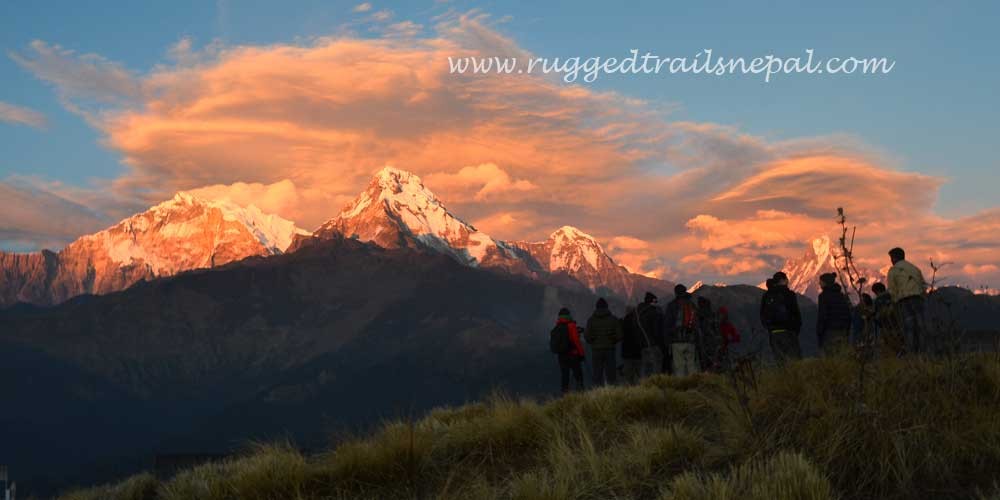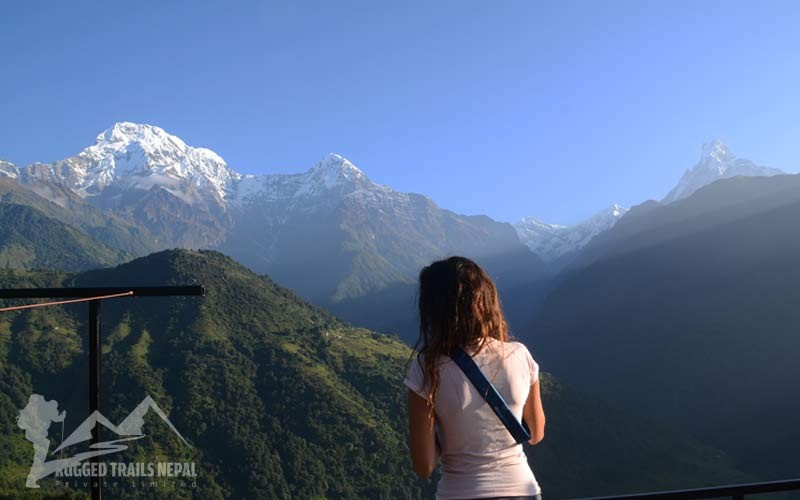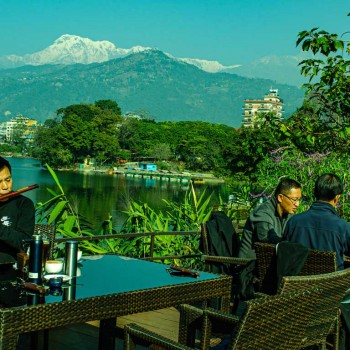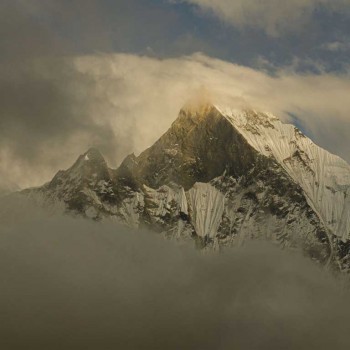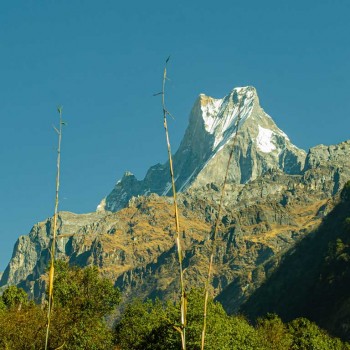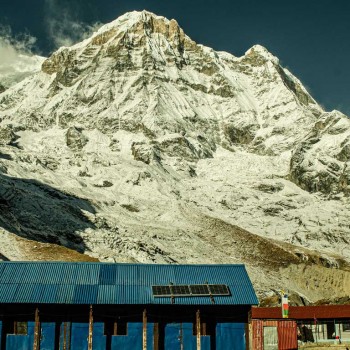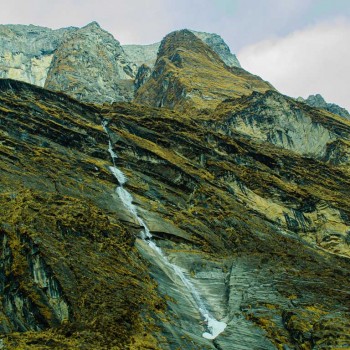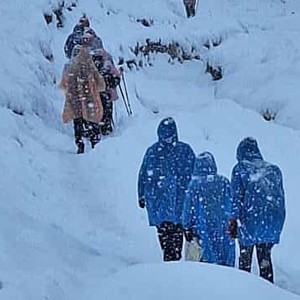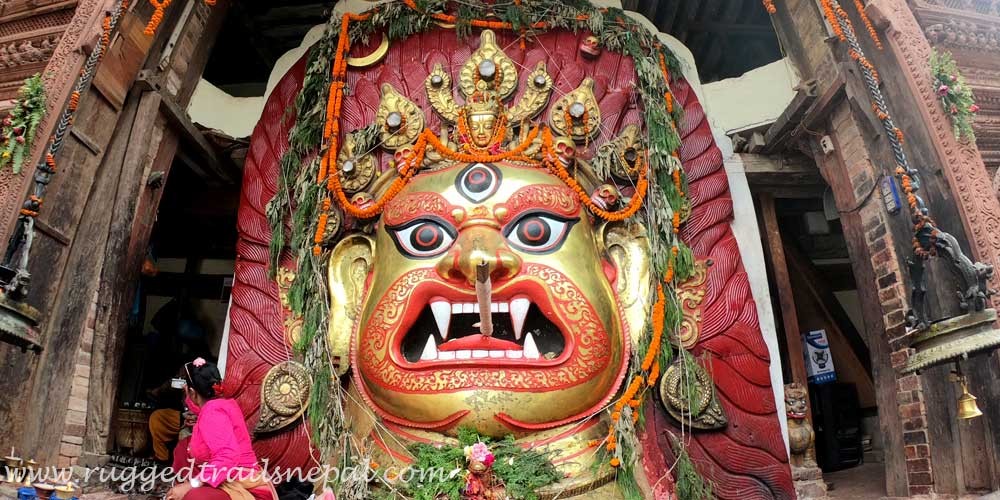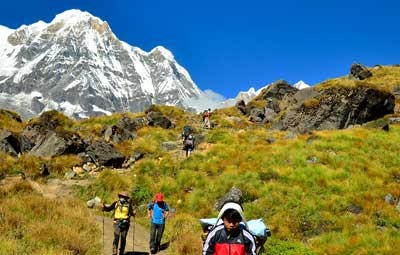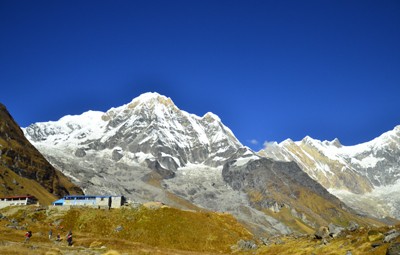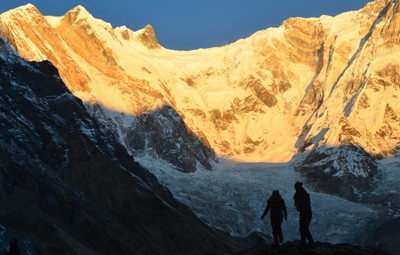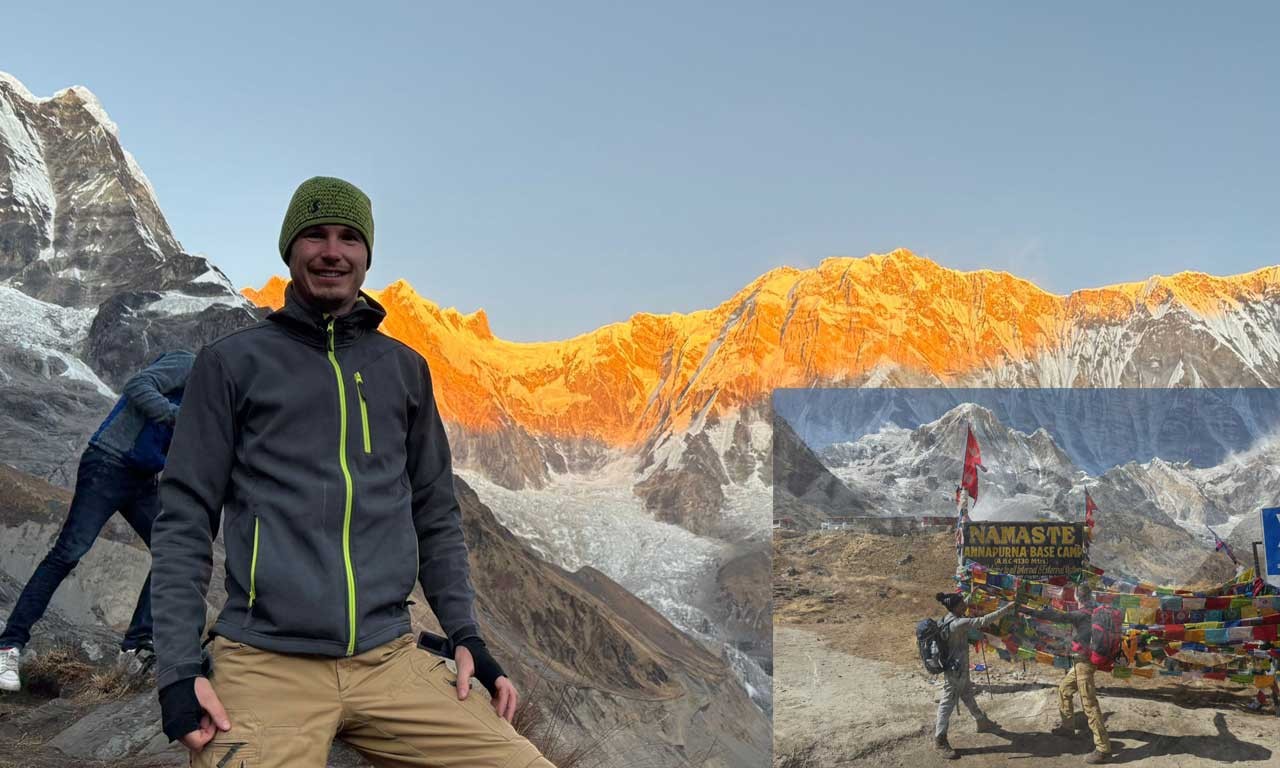The Annapurna Base Camp Trek, also known as the Annapurna Sanctuary Trek, is a 13-day trek that takes you from the highs of Annapurna Base Camp, Ghorepani Poon Hill, and to the lows of the peaceful city of Pokhara. The Annapurna region is known to be one of the popular destinations in Nepal for various reasons and the main is trekking and hiking. The vast diversity of the landscape, the rich cultures, and the panoramic views of the Himalayas all combine to create a mystical and unique experience. Mt. Machhapuchre, also known as Mt. Fishtail (6,993 m), will be visible throughout the route, providing you with the perfect photographic opportunities in the morning and evening as the rays of the setting sun hit the majestic mountain alongside other peaks in the Annapurna range.
The Annapurna Base Camp Trek with Ghorepani Poon Hill starts in the cultural heritage town of Kathmandu. You will be met at the Kathmandu airport, and the Annapurna trek begins with a guided city tour. Starting from Kathmandu means you will meet your guide and the team from Rugged Trails Nepal, who will give you a complete overview of the trip as well as a warm welcome. We will help you check your trekking gear and make sure you have everything you need for the big hikes ahead.
Depending on your chosen package, you will either drive or fly to Pokhara from Kathmandu in the morning. Your hotel will be pre-booked in Pokhara, so you can check in and enjoy the peaceful town with the beautiful Fewa Lake next to your hotel. The mountains will be clearly visible from Pokhara, and you will soon be reaching the lap of those mountain peaks.
This Annapurna Base Camp trek itinerary is longer than some others, as it covers Ghorepani Poon Hill, Tadapani, and other places. This gives you more time to explore the Annapurna Foothills. If you are looking for ashorter ABC Trek from Pokhara, you can find a link below. However, if you have the time, we would highly recommend this itinerary. The last section of the walk returns hikers to Pokhara, where they may unwind and consider their incredible adventure.
Join Rugged Trails Nepal on this epic trek through the lowland jungles, terraced hills, hot springs, lush rhododendron forests, and quaint villages. Climb to the high mountains to find the epic beauty of what is known as the Annapurna Sanctuary Trek, surrounded by an amphitheatre of sacred mountains. Come and discover with your own eyes why this trek remains ever-popular among trekkers.
What are the best things to see and do on the Annapurna Base Camp trek?
World Heritage Sites Visited in Kathmandu: Durbar Square, Swayambhunath, and Pashupatinath are just a few of the UNESCO World Heritage Sites that can be found in Kathmandu, the capital city of Nepal. For anybody interested in Nepal's rich history and culture, these historic places are a must-visit.
Beautiful Pokhara city with a view of the mountains and lakes: Pokhara is a lovely city situated in the Himalayan foothills. The city is renowned for its numerous lakes and rivers as well as its breathtaking vistas of the Annapurna range. Before or after their trip to Annapurna Base Camp, hikers frequently stop in Pokhara for a few days.
The breathtaking views from Poon Hill, the route, and Annapurna Base Camp: The breathtaking view is one of the attractions of the Annapurna Base Camp Trek. Trekkers may take in expansive vistas of the Annapurna range, including the tenth-highest peak in the world, Annapurna I, from Poon Hill. Trekkers will pass through verdant forests, terraced farms, and little communities along the way. From Annapurna Base Camp, the vistas are truly stunning.
The Cultural Experience: Trekkers will get the chance to learn about the locals' culture and way of life because the Annapurna region is home to a rich culture. Trekkers frequently stop at teahouses along the journey, giving them the opportunity to meet locals and learn about their culture.
The Challenge to Reach Annapurna Base Camp: The trip to Annapurna Base Camp is a fairly challenging one, but it is also incredibly rewarding. Trekkers who finish the journey will experience an unsurpassed sense of accomplishment. The walk will test your physical and mental stamina.
Meeting with new people: Hikers, if you like to meet new people from all over the world, trekking is a terrific way to do so. Hikers frequently develop strong ties with one another, and these friendships can endure a lifetime.
Healing Himalayas: The Himalayas are considered to have medicinal characteristics, and many hikers say they feel revitalised after their climb. The fresh air, the breathtaking scenery, and the challenge of the journey can all affect one's sense of well-being.
Jhinu Hot Spring: The water from the springs is purported to have therapeutic qualities and is thought to be beneficial in treating a number of illnesses, including skin conditions, arthritis, and rheumatism. Travellers and hikers who want to unwind and soak in the warm waters frequent the springs as well.
Annapurna Base Camp Trek or Everest Base Camp Trek?
The Everest Base Camp Trek and the Annapurna Base Camp Trek are two of Nepal's most well-known hiking routes. Despite having differing rewards and difficulties, both hikes provide breathtaking views of the Himalayas.
A moderate trip that takes 5–13 days to complete is the Annapurna Base Camp trip. It is a fantastic choice for hikers seeking a strenuous but rewarding journey without the extremely high altitude of Everest Base Camp. While the Everest Base Camp Trek's highest point is 5,364 meters high, the Annapurna Base Camp Trek's highest point is 4,130 meters high.
A more difficult trip that takes 14–21 days to complete is the Everest Base Camp trip. Trekkers who are in good physical shape and want a really epic adventure might consider it. Additionally, the Annapurna Base Camp Trek is more costly than the Everest Base Camp Trek.
| Feature | Annapurna Base Camp Trek | Everest Base Camp Trek |
| Difficulty | Moderate | Strenuous |
| Duration | 5 to 13 Days | 14 to 16 Days |
| Altitude | 4,130 M | 5,545 M (18,192 ft) |
| Cost | Less expensive | Quite Expensive |
| Starting Point. | Pokhara | Lukla |
Annapurna Base Camp Trek from Pokhara
The hike from Pokhara to Annapurna Base Camp is the most well-known way to reach the base camp. Starting in Pokhara, a lovely lakeside town, the story takes place. Trekkers drive to Jhinu Bridge, where the hike starts, from Pokhara. Up to the Annapurna Base Camp, the journey follows the Modi Khola River valley. Rough Paths One of the most popular trekking routes from Pokhara to the Annapurna Region is the short Nepal Annapurna Base Camp Trek. Follow the link below to the Short Annapurna Base Camp Trek if you're only looking for the fastest route to get there. If you are already in Pokhara and looking for the 7 Annapurna Base Camp Trek, then write us to get the new trip cost.
What is the best time of year to do the Annapurna Base Camp Trek?
- Autumn/Fall
The best months for hiking in Nepal are September through November. It's dry and clear outside, with bright sunny days and excellent visibility. The best time to go hiking is also when there are fewer risks of weather-related natural disasters. Since this is Nepal's biggest trekking season, the routes are also crowded during this period.
- Spring
The spring season, which lasts from March through May, is regarded as the second-best choice. The weather is mostly clear, though it is a touch cool, especially further up. The morning sun is shining, and flowers are in full bloom. Snow, however, has a greater likelihood of occurring.
- Season of Summer (June to August)
Warm, muggy weather as well as limited vision owing to clouds and mist are all characteristics of the monsoon season. Another significant issue at this time of year is leeches. Despite the fact that, throughout this period, we have successfully completed several hikes,. If you plan to go on a hike during this time, the sight of the moving clouds, snow-capped mountain peaks, and lush vegetation will leave you in awe.
- Season of Winter
From December through February, cold temperatures are common at higher altitudes. This time of year is unsuitable for the ABC Trek because of the snow and ice. Because there may likely be some avalanches during this time, we really don't advise ABC Trek. Because our guides are familiar with the routes and every inch of the trekking paths, we haven't had any casualties. We advise lower-elevation treks, such as those in the Annapurna region, the Kathmandu Valley Rim Trek, etc., if you are still interested in hiking.
How difficult do trekkers find the Annapurna Base Camp Trek?
Some people may wonder if the Annapurna Base Camp Trek is difficult. After all, Malaysian toddlers have completed the ABC trek, even though they were just a few months shy of their first birthday. However, it's important to note that the toddlers were not walking during the trek. We are talking about altitude sickness here. The trek is designed with altitude in mind, so it is important to be physically and mentally prepared for the high altitude. You don't need to be an athlete to complete the trek, but you should be prepared for a 5-7 hour walk with a small daypack. Cycling, swimming, and stair climbing are all good ways to prepare for the trek. If you practice yoga or deep breathing exercises, that is also beneficial.
- Six weeks or more before the expedition, begin your training.
- Increase your exercise time and intensity little by little.
- Sleep a lot and maintain a balanced diet.
- If you have any health worries, discuss them with your doctor.
- Know the signs of altitude sickness and how to respond if you experience them.
How many days does it take to trek to Annapurna base camp?
The shortest Annapurna base camp trek can be arranged for 5 days in total, which is speedy and for pure hikers, but for average hikers and for beginners, the 7 days trek itinerary is perfect. On this trek package, we have covered Ghorepani Poon Hill as well as Kathmandu and Pokhara.
What gear do I need for the Annapurna Base Camp Trek?
You don't need a lot of specialised gear or equipment for this teahouse hike to the Annapurna Base Camp. As this is a teahouse hike, we won't need to bring food. There are a few necessities, though. To get an idea of the equipment you'll need for hiking, click the link.
Is travel insurance necessary for the trek to Annapurna Base Camp?
Yes, having travel insurance that includes medical evacuation and search and rescue for the Ghorepani Annapurna Base Camp is required. Additionally, it's crucial to thoroughly review your policy's exclusions. Our suggestion is Worldnomads.


